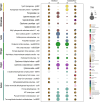The chemosynthetic biofilm microbiome of deep-sea hydrothermal vents across space and time
- PMID: 40660416
- PMCID: PMC12261850
- DOI: 10.1186/s40793-025-00738-x
The chemosynthetic biofilm microbiome of deep-sea hydrothermal vents across space and time
Abstract
Microbial biofilms colonize mineral and biological substrates exposed to fluid circulation at deep-sea hydrothermal vents, providing a biologically active interface along redox boundaries. Since many biofilms at deep-sea vents are associated with invertebrates, microbial distribution and abundance are not only constrained by local fluid geochemistry, but also through host-microbe interactions. This study examined the spatial distribution and diversity of established microbial biofilm communities collected from three distinct biological regimes characteristic of the East Pacific Rise (9°50 N, 104°17 W) vent system, as well as newly established biofilms on experimental microbial colonization devices. Transcripts from 16S rRNA-based amplicon sequencing revealed that Campylobacterota of the Sulfurimonas and Sulfurovum genera dominated newly-formed biofilms across all biological regimes. Statistical analyses using environmental chemistry data from each sampling site suggest that community composition is significantly impacted by biofilm age, temperature and sulfide concentration ranges, and to a lesser extent, locality. Further, metatranscriptomic analyses were used to investigate changes in community gene expression between seafloor and subseafloor biofilms. Our findings revealed differences in the type and abundance of transcripts related to respiratory pathways, carbon fixation and reactive oxygen species (ROS) detoxification. Overall, this study provides a novel conceptual framework for evaluating biofilm structure and function at deep-sea vents by showing a transition from a niche-specific pioneer microbial community in newly-formed biofilms, to a complex population of increased diversity in established biofilms and by identifying key changes in gene expression in taxonomically similar biofilms during the transition from the shallow subseafloor to the seafloor.
Keywords: Sulfurimonas; Sulfurovum; Biofilms; Campylobacterota; Chemosynthesis; Deep-sea hydrothermal vents; Metatranscriptome; Succession.
© 2025. The Author(s).
Conflict of interest statement
Declarations. Competing interests : The authors declare no conflict of interest.
Figures





Similar articles
-
Ecological differences among hydrothermal vent symbioses may drive contrasting patterns of symbiont population differentiation.mSystems. 2023 Aug 31;8(4):e0028423. doi: 10.1128/msystems.00284-23. Epub 2023 Jul 26. mSystems. 2023. PMID: 37493648 Free PMC article.
-
Microbial communities associated with plastic fishing nets: diversity, potentially pathogenic and hydrocarbon degrading bacteria.Sci Rep. 2025 Jul 2;15(1):22877. doi: 10.1038/s41598-025-06033-6. Sci Rep. 2025. PMID: 40594211 Free PMC article.
-
NEOLEBOURIA MULLINEAUXAE N. SP. (TREMATODA: DIGENEA) AND ANOTHER OPECOELID FROM DEEP-SEA HYDROTHERMAL VENT FIELDS OFF CENTRAL AMERICA AND PAPUA NEW GUINEA, WITH SPECIES KEYS AND A COMPARISON TO MESOBATHYLEBOURIA.J Parasitol. 2025 Jul 1;111(4):451-478. doi: 10.1645/24-113. J Parasitol. 2025. PMID: 40659347
-
The effect of sample site and collection procedure on identification of SARS-CoV-2 infection.Cochrane Database Syst Rev. 2024 Dec 16;12(12):CD014780. doi: 10.1002/14651858.CD014780. Cochrane Database Syst Rev. 2024. PMID: 39679851 Free PMC article.
-
A rapid and systematic review of the clinical effectiveness and cost-effectiveness of paclitaxel, docetaxel, gemcitabine and vinorelbine in non-small-cell lung cancer.Health Technol Assess. 2001;5(32):1-195. doi: 10.3310/hta5320. Health Technol Assess. 2001. PMID: 12065068
References
-
- Alain K, Zbinden M, Le Bris N, Lesongeur F, Quérellou J, Gaill F. Early steps in microbial colonization processes at deep-sea hydrothermal vents. Environ Microbiol. 2004;6:227–41. - PubMed
Grants and funding
LinkOut - more resources
Full Text Sources
